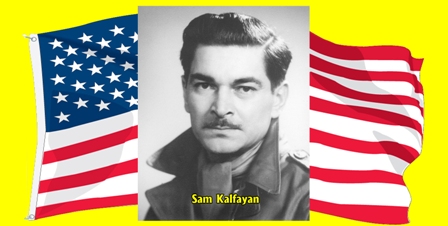|
Sam Kalfayan was born in 1911 in Samson, Turkey, of Armenian parentage. Because of the Armenian Genocide by the Turkish Government (1914-1920), Sam’s family fled to Cairo, Egypt. From 1914 to 1921 Sam and his Mother (Sam’s Father was a victim of the genocide) lived in Cairo where Sam attended the local Armenian school. As a youngster Sam played with the Arab children and easily learned the Arabic language. Because French was the cosmopolitan language throughout the world prior to World War II, the Armenian schools in Cairo taught students the French language. At the young age of ten, Sam already spoke fluent Armenian, Turkish, Arabic, and French. In May 1921, Sam and his Mother immigrated to the United States. He grew up in the San Joaquin Valley in the central part of California, attending local schools, graduating from Dinuba High School in 1930. Sam farmed for a living and worked as Federal and State Fruit and Vegetable Inspector to meet financial needs. In 1941, Sam volunteered for the Army Air corps hoping to become a Ferry Command Pilot. He was soon discharged and returned home to farm. In 1943 he entered the U.S. Army, receiving basic training at Camp Roberts, California. When the commanding officer learned of Sam’s knowledge of 5 languages, he was tested and shipped to Washington, DC. Following investigation of Sam’s background and proficiency in foreign languages, he was shipped to England. Shortly after arriving the Third Army was formed in France and Sam was designated Clerk-Interpreter under General George S. Patton Headquarters from Saint Lo to Bad Toelz, until the war ended on May 6, 1945. During this period Sam was a participant of the “Battle of the Bulge” assault. Years later he received (as a token of appreciation) a personally signed picture from King Albert II and Queen Paola of Belgium for his part in saving Belgium from the German Nazi plunder. In July 1945, Sam was transferred from 3rd Army Headquarters to General Eisenhower’s office in Berlin Supreme Headquarters, American Expeditionary Force (SHAEF), as interpreter in the Finance Intelligence and Liaison Office. In November 1945, Sam returned home on emergency basis as requested by the Red Cross. During Sam’s service overseas his wife had become mentally ill and eventually committed suicide. Although Sam returned safe from the war, his wife was actually a war casualty. Upon his return from overseas, Sam worked for the United States Bureau of Reclamation and concurrently attended Fresno State College, graduating in 1950. He attended the University of California, Berkeley, receiving an MS in agricultural economics, then served five years as the economist and statistician for the California Raisin Industry. In 1956, the City of Fresno, County of Fresno, and the City of Clovis formed a combined planning commission to plan and formulate a master land use plan encompassing two hundred square miles. Sam was employed as an Economic Planning Consultant for the economic portion of the master plan. In 1957, the City of Fresno invited him to become the City’s economic planner. In 1961 Sam left Fresno and went south to become Intern City Manager during the day at Manhattan Beach and student at the University of Southern California at night to receive a Master of Public Administration Diploma. From 1962 to 1975, Sam was invited by the Riverside County Administrator to manage newly incorporated cities. In 1966 he was called to Washington, D. C. by the State Department, interviewed, and investigated to be sent to Vietnam as Civilian Governor of regional areas conquered by the United States Military Forces. Due to a disagreement on grade and salary offered, Sam did not accept the appointment. Returning to Riverside County, he managed San Jacinto, Desert Hot Springs, Norco, and Elsinore. These newly incorporated cities began operation financially broke, requiring a manager versed in municipal government and with a high degree of proficiency in financial operations. The Fresno Exchange Club, early in 1994, met in the Legion of Valor Museum to conduct its weekly business, and concurrently visit the museum. Sam was enamored by the quality and historic value of the museum and inquired if he could help with the operation of the museum. He was subsequently invited to perform the duties of a docent. Sam became very knowledgeable of the military history displays at the museum. He was an honest, straight forward individual, and could be depended upon to render comprehensive and helpful suggestions toward the day-to-day running of the museum. Sam was a tremendous asset, and the Legion of Valor Museum was very fortunate to have had him as a member of its staff. |

